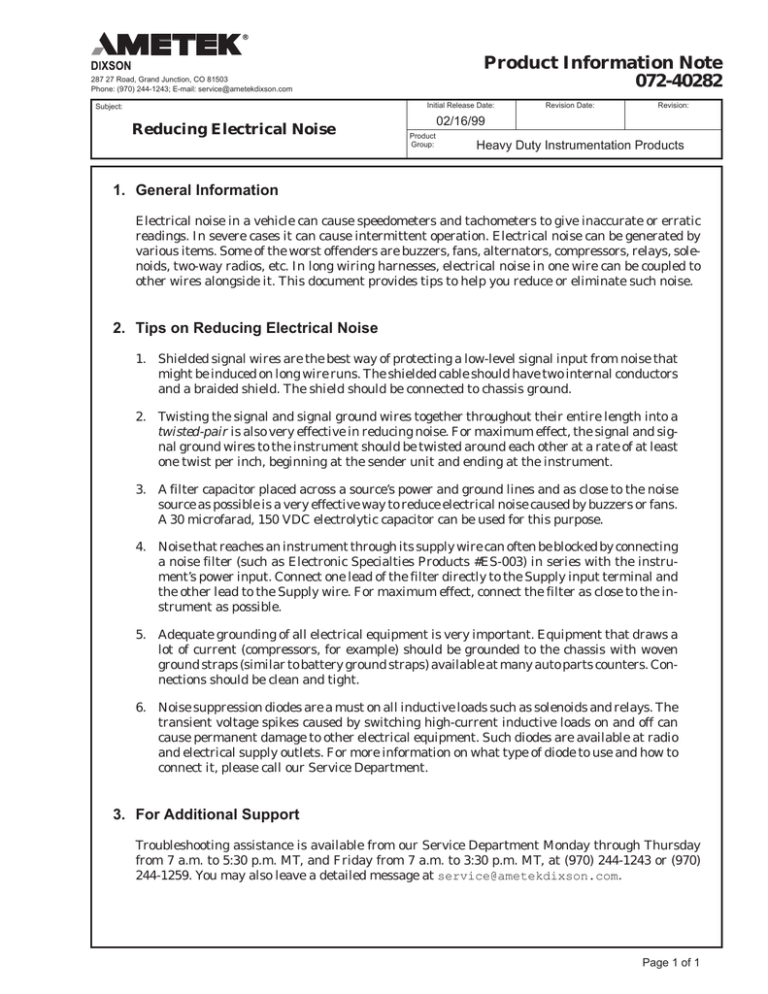Reducing Electrical Noise
advertisement

Product Information Note 072-40282 287 27 Road, Grand Junction, CO 81503 Phone: (970) 244-1243; E-mail: service@ametekdixson.com Initial Release Date: Subject: Reducing Electrical Noise Revision Date: Revision: 02/16/99 Product Group: Heavy Duty Instrumentation Products 1. General Information Electrical noise in a vehicle can cause speedometers and tachometers to give inaccurate or erratic readings. In severe cases it can cause intermittent operation. Electrical noise can be generated by various items. Some of the worst offenders are buzzers, fans, alternators, compressors, relays, solenoids, two-way radios, etc. In long wiring harnesses, electrical noise in one wire can be coupled to other wires alongside it. This document provides tips to help you reduce or eliminate such noise. 2. Tips on Reducing Electrical Noise 1. Shielded signal wires are the best way of protecting a low-level signal input from noise that might be induced on long wire runs. The shielded cable should have two internal conductors and a braided shield. The shield should be connected to chassis ground. 2. Twisting the signal and signal ground wires together throughout their entire length into a twisted-pair is also very effective in reducing noise. For maximum effect, the signal and signal ground wires to the instrument should be twisted around each other at a rate of at least one twist per inch, beginning at the sender unit and ending at the instrument. 3. A filter capacitor placed across a source’s power and ground lines and as close to the noise source as possible is a very effective way to reduce electrical noise caused by buzzers or fans. A 30 microfarad, 150 VDC electrolytic capacitor can be used for this purpose. 4. Noise that reaches an instrument through its supply wire can often be blocked by connecting a noise filter (such as Electronic Specialties Products #ES-003) in series with the instrument’s power input. Connect one lead of the filter directly to the Supply input terminal and the other lead to the Supply wire. For maximum effect, connect the filter as close to the instrument as possible. 5. Adequate grounding of all electrical equipment is very important. Equipment that draws a lot of current (compressors, for example) should be grounded to the chassis with woven ground straps (similar to battery ground straps) available at many auto parts counters. Connections should be clean and tight. 6. Noise suppression diodes are a must on all inductive loads such as solenoids and relays. The transient voltage spikes caused by switching high-current inductive loads on and off can cause permanent damage to other electrical equipment. Such diodes are available at radio and electrical supply outlets. For more information on what type of diode to use and how to connect it, please call our Service Department. 3. For Additional Support Troubleshooting assistance is available from our Service Department Monday through Thursday from 7 a.m. to 5:30 p.m. MT, and Friday from 7 a.m. to 3:30 p.m. MT, at (970) 244-1243 or (970) 244-1259. You may also leave a detailed message at service@ametekdixson.com. Page 1 of 1




